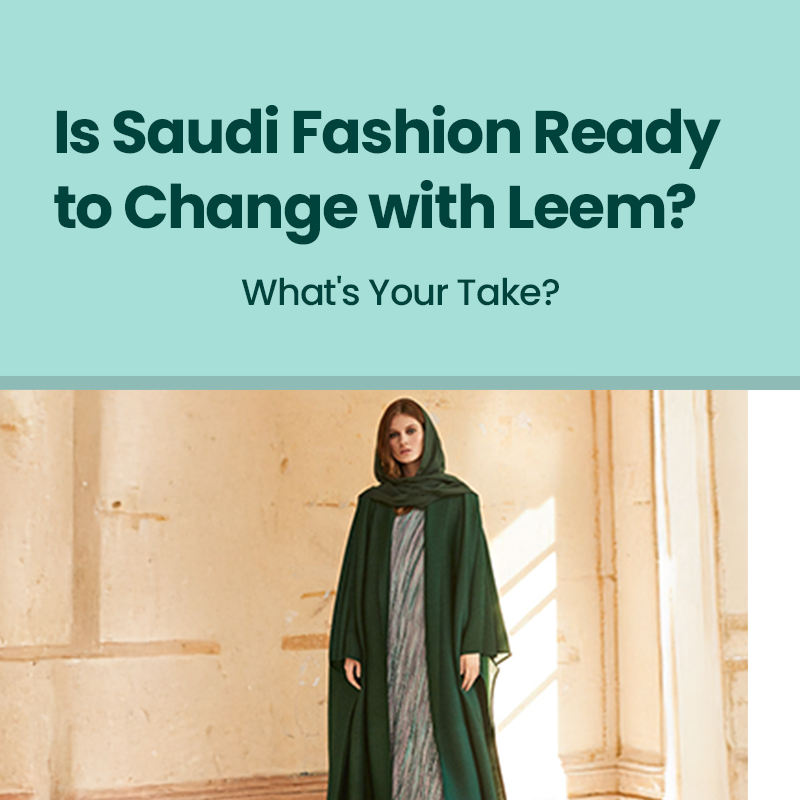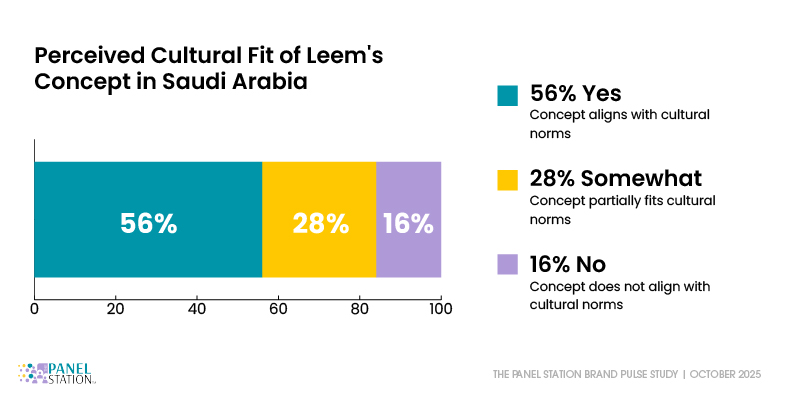

Is Saudi Arabia Ready for a Fashion Makeover with Brands Like Leem?
Fashion in Saudi Arabia has always been more than just what you wear. It’s a reflection of heritage, values, and identity. For decades, abayas and tailored thobes defined not just wardrobes but also a nation’s aesthetic pride. Yet today, as malls brim with contemporary brands and social media turns fashion into everyday conversation, one question naturally arises:
Can modern fashion truly coexist with Saudi tradition?
Brands like Leem are confidently saying yes. With their promise of “where modern meets modest,” Leem aims to bridge the gap, stitching a modern twist into traditional fabrics and redefining what elegant modesty looks like for the Saudi woman and men of today. Their collections promise balance: contemporary silhouettes that stay true to cultural roots, while celebrating self-expression and sophistication.
To understand whether Leem’s message resonates with Saudi consumers, we conducted an online survey across KSA, hearing directly from shoppers, trendsetters, professionals, and homemakers. The results reveal not just what people think about Leem, but what they feel about Saudi fashion itself and where it’s headed next.
Who We Spoke To?
Our survey reached a wide spectrum of respondents across Saudi Arabia, representing voices from all walks of life. Nearly 40% were between the ages of 25–34, a group that straddles tradition and modernity. Another 32% fell between 16–24, representing the country’s fashion-forward youth. Interestingly, 18% were aged 35–49, showing that mid-career professionals also have opinions on how Saudi fashion should evolve.
Gender distribution tilted towards women (around 60% female respondents), unsurprisingly, since Leem primarily designs for women. But male respondents also had their say, often with comments like, “It looks nice, but too fashion-forward for family events.” (We’ll get to that part soon.)
When asked what type of clothing they buy most often, 52% chose modest everyday wear, 29% leaned toward casual modern clothing, while 19% said they still prefer traditional attire. That right there hints at a cultural pivot which is subtle, but unmistakable.
Share Your Opinions, Shape The Brands That Feels Right for You
First Impressions Matter and Leem’s Are Mixed but Positive
Does Leem Fit Saudi Cultural Norms?
When asked if Leem’s concept aligns with Saudi cultural norms, 56% said yes, 28% said somewhat, and only 16% said no.
That 28% “somewhat” group reflects a generation that’s cautious, not resistant. For them, fashion isn’t about rejecting modesty. It’s about reinterpreting it comfortably within the boundaries of family, culture, and faith.
As one 29-year-old respondent from Dammam said:
“Leem is beautiful, but sometimes I wonder if my aunties would think it’s too modern for Eid.”
That sentiment shows that Saudis are learning to merge pride in tradition with the confidence to dress with modern elegance.
Family Gatherings: The True Litmus Test
When asked if they’d feel comfortable wearing Leem at family gatherings, 46% said yes, 33% said somewhat, and 21% said no.
Younger respondents led the charge. 58% of those aged 16–24 felt confident wearing Leem around family, compared to 35% among those aged 35–49. That’s a clear sign of generational evolution. The youth are comfortable redefining what is “appropriate,” while older generations are observing this shift with respect and cautious curiosity.
In other words, Leem’s designs aren’t replacing the abaya. They’re expanding what it means to dress modestly and beautifully.
Are Saudis Ready for Modern Clothing with Traditional Touches?
The answer is a resounding YES. The vast majority of respondents embraced the idea of blending modern styles with traditional elements, with very few rejecting it outright.
Young Saudi women, especially those aged 18–34, are stepping into public spaces like never before, thriving in workplaces, social settings, and creative industries. They’re not looking to abandon their cultural identity; they’re looking for fashion that grows with them.
But what actually drives their purchasing decisions? When choosing fusion clothing, Saudis prioritize comfort and fabric quality above all else followed closely by cultural appropriateness and modesty.
Saudis are open to evolution, as long as it feels effortless and authentic.
Fashion as Self-Expression
Among young Saudis, 71% said fusion fashion helps them express their individuality, 19% said somewhat, and just 10% said no. Fashion, once seen primarily as a measure of modesty, is now a reflection of meaning and confidence.
The younger generation isn’t turning away from heritage. They’re just styling it differently. They want to express who they are within the framework of who they’ve always been.
That’s the future of Saudi fashion in one sentence — connected, confident, and culturally proud.
The Bigger Picture: What This Means for Leem and Saudi Fashion
The data paints a hopeful picture: Saudi consumers, especially younger women, are embracing modernity while staying grounded in cultural values.
Still, Leem faces a few challenges:
• Price sensitivity: As a mid-premium brand, Leem appeals to aspirational buyers but can further expand by offering more accessible collections.
• Cultural reassurance: The “somewhat comfortable” segment is Leem’s greatest opportunity — a group that’s curious and open but still needs reassurance through storytelling rooted in heritage.
• Authenticity: As fusion fashion becomes more common, Leem must ensure its designs continue to feel authentically Saudi, not superficially global.
Leem’s path forward isn’t about choosing between old and new — it’s about proving they can beautifully coexist.
The Future of Fashion in KSA
Saudi Arabia’s fashion scene is in the midst of a quiet revolution — one that celebrates innovation without letting go of identity. From global collaborations to homegrown designers, the narrative is evolving from imitation to individual expression.
Brands like Leem stand at the center of this transformation, showing that modest fashion can be expressive, confident, and distinctly local. As one respondent beautifully put it:
“We don’t want Western clothes. We want Saudi clothes that feel global.”
That sentiment perfectly captures today’s Saudi spirit, rooted in tradition yet unafraid of modernity.
Our survey reflects this journey clearly: Saudi fashion is redefining what fusion means. It is about wearing the heritage with pride, purpose, and a fresh sense of identity.
If Leem continues to listen to its audience prioritizing comfort, modesty, and design innovation it will shape the future of Saudi cultural expression.
Because in the end, Saudi fashion is about weaving the past and future together, seamlessly, stylishly, and proudly.

Your opinions shape things you love, Make your voice count by sharing your opinions.
About Author : Soneeta
A bookworm at heart, traveler by soul, and a sports enthusiast by choice. When she is not exploring new places, you’ll find her curled up with her pets, binge-watching movies. Writing is her forever sidekick. Soneeta believes that stories are the best souvenirs you can collect. Basically, she is fueled by books, adventures, and a whole lot of pet cuddles.


